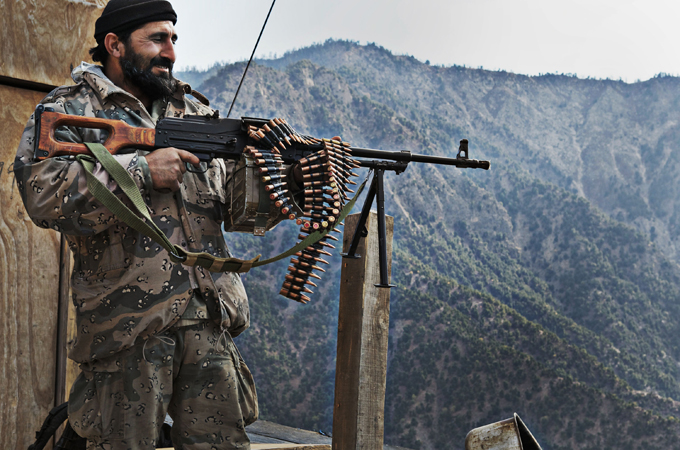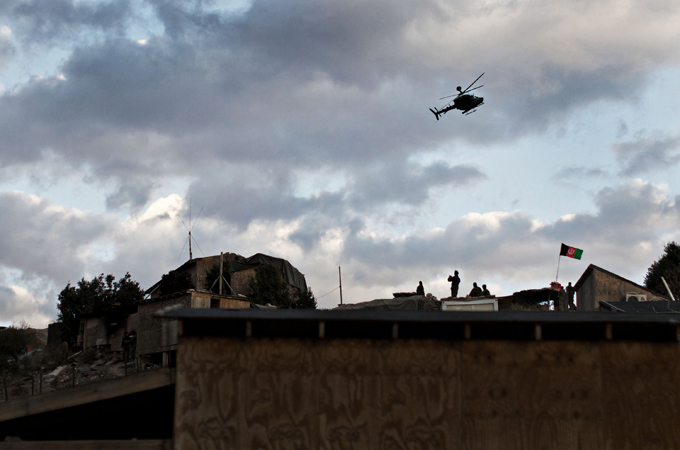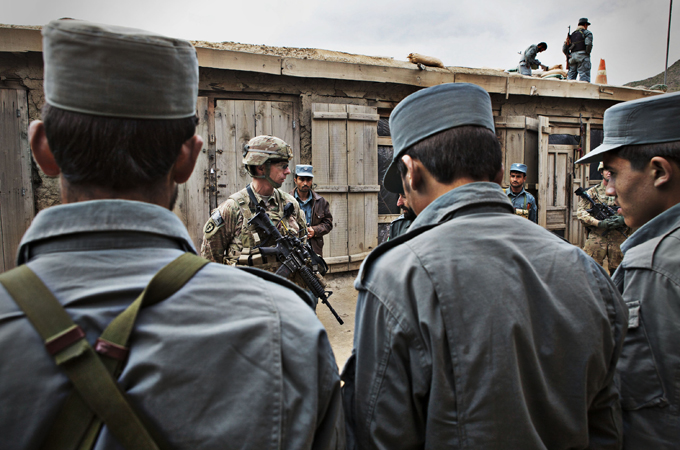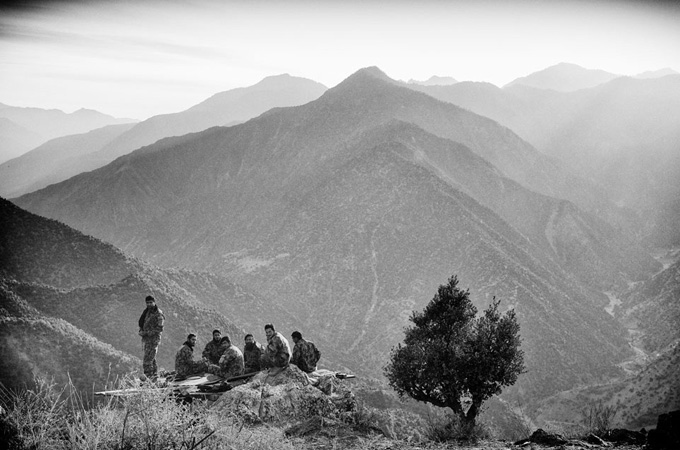
The Winter War
In the frozen peaks of Afghanistan’s Kunar province, a ferocious clash for supremacy rages amid the mountaintops.
Filmmaker: John D McHugh
Barack Obama, the US president, has pledged to withdraw American forces from Afghanistan by 2014, with other NATO nations set to pull out their troops before that date and overall responsibility for security gradually being handed to the Afghan National Army and police.
Following the announcement last month from the Taliban that they are prepared to open a political office in Qatar – a step which may facilitate a move towards negotiations and a peaceful settlement – many people hope that the end of Afghanistan’s long and brutal war may just be in sight.
|
But there is a long way to go yet and many ways in which any deal could be upset by events. General John Allen, the senior American commander on the ground, has publicly expressed doubts that a full military withdrawal by 2014 is feasible and, as many experts point out, fighting in parts of Afghanistan is just as fierce as it has always been.
This is especially so in two strategically vital provinces, Kunar and Nuristan, which sit on Afghanistan’s mountainous north-eastern border with Pakistan. Since US troops arrived in the country 11 years ago, the area has seen sustained and intense violence. In 2009, with casualties rising, the Americans withdrew entirely from Nuristan. The following year northern Kunar was also handed over to Afghan control. But within a few months, the Taliban had retaken the area, infiltrating through vital border crossings and completely undermining attempts by Afghan forces to maintain security across the region.
So now US forces have returned to the area, this time to the frozen peaks as well as the valleys, determined to re-establish their military dominance and win over the local population before they go. The Taliban are just as keen to see them defeated and the result is an intermittent but occasionally ferocious clash for supremacy amid the mountain tops. Both sides know that what happens here may yet decide the success or failure of NATO’s war and indeed the future of Afghanistan itself.
This winter People & Power sent filmmaker John D McHugh to the frontline of this remote but important struggle, to assess the willingness and capacity of the combatants to see it through to a definitive conclusion. The film is the first in a series of occasional reports that will address aspects of Afghanistan’s preparedness to handle its own security and affairs beyond 2014.
| Filmmaker’s view |
Bent over on one knee, as the wind and dirt slammed against me, I clung tightly to my rucksack and cameras. I could hear and feel the powerful Chinook’s rotors tearing through the air above my head, but I didn’t dare look up. It was past midnight, and the moon had already set. The skies in Nuristan are free from light pollution and the stars sparkle in the sky. I knew the helicopter would be silhouetted against the stars, but even with my ballistic glasses and scarf wrapped tightly around my face, the wash of the blades was so strong that raising my head before it landed would simultaneously blind and choke me.
Finally, the engine noise changed, and I knew the pilots had managed the difficult descent onto the tiny mountain-landing zone at Observation Post (OP) Mace. Heaving my bag onto one shoulder, I stumbled forward in the darkness, trying not to smash my shin against the lowered rear ramp of the bird, always a danger in these nighttime operations. There had been no Taliban shooting this time, but overhead I could hear the armed escort of Kiowas ready to return fire as they had many times over the previous days.
I had landed in the dark 12 days earlier. That had been a much bigger event, with several groups of soldiers waiting their turn as the huge workhorse Chinooks ferried back and forth from Forward Operating Base Bostick onto the mountaintop OP Mace.
OP Mace sits 1,000 metres from the Pakistan border. It over watches a checkpoint on the Landay Sin River, a crossing point from the town of Gowerdesh into Pakistan. Gowerdesh is in the Kamdesh district, which according to the local Afghans, is in Nuristan province. On US military maps it is located in Kunar province. Either way, it is a dangerous area. The district has several local groups of fighters opposed to the Afghan government, as well as Taliban and al-Qaeda fighters eager to kill Americans and their Afghan security partners. Peace seems very far away.
Symbolism and sorrow
 |
| The Nuristan and Kunar region has seen some of the fiercest fighting in the past 10 years [John D McHugh] |
The Nuristan and Kunar region has seen some of the fiercest fighting in the 10 years since the US came to Afghanistan and ousted the Taliban. There have been heavy casualties (almost 180 US soldiers killed at the end of 2011), and the area echoes with place names heavy with symbolism and sorrow; Keating, Wanat, Korengal, and the Pech have become synonymous with death, and defeat.
In 2010, US commanders decided that the mountainous, sparsely populated area was not worth the blood and treasure required to hold it, and quietly began to slip away. Combat Outposts and OPs were handed over to the Afghan National Army (ANA) and the Afghan Border Police (ABP). Many of these were attacked and overrun by the Taliban. Others were preemptively abandoned by the Afghan security forces (ANSF).
In June 2011, Gowerdesh checkpoint was overrun. The Taliban killed 23 of the Afghan Border Police manning it. They then made a gruesome video of the young policemen’s remains, desecrating and dishonouring the bodies while holding their captured weapons aloft as trophies.
The whole point of the Americans’ operation at OP Mace was to help the Afghan Border Police rebuild their destroyed checkpoint at the base of the mountain, while at the same time getting the Afghan army and the police to work together. But what the Americans describe as inter-service rivalry between their own US marines, US army, US navy and US air force is far removed from the dissension between the Afghan National Army and the police. Each group protects the influence they have, and this reflects the tribal mentality that pervades every aspect of life in Afghanistan.
Overwhelming confidence or pure stupidity?
 |
| That the Taliban stand only the tiniest chance of hitting a helicopter does not stop them trying [John D McHugh] |
As we crammed ourselves into the low-slung cargo seats of the Chinook, abandoning any effort to strap ourselves in, I thought back over my time on the mountaintop. For the first nine days there had been a lot of shooting. Not the up close and personal kind of close quarter combat that I have come to expect in Afghanistan, especially in this eastern part. No, rather it had been Taliban taking pot shots at the helicopters followed by massive retaliation from the pilots. Not a fair fight at all, and I wondered again and again what the Taliban were trying to achieve. There was only the tiniest chance that they would even hit a helicopter, let alone bring one down. This slight possibility pitched against the guaranteed retribution of the heavily armed flying machines suggested either overwhelming confidence, or pure stupidity. I never could decide which.
The culmination had come on the ninth day, the American festival of Thanksgiving. Well aware of its significance to the US troops, the Taliban had launched a complex attack, with multiple weapons systems firing from separate locations. I saw one US sniper push the Thanksgiving meal laid out on cardboard boxes to one side as he set up his .50mm Barrett rifle to return fire. Other soldiers shoveled food from heavily laden plates into their mouths as they scanned the surrounding ridgelines, looking for the telltale puffs of smoke that would give away Taliban fighting positions. They have become so inured to the fighting that it does not spoil their appetite any more. Once again, massive aerial bombardment was brought to bear, and the attack petered out.
Over the course of my stay on Mace I witnessed the truly awesome firepower that the US military brings to a fight. Between their helicopters and jets they had dropped 19 bombs, fired two Hellfire missiles, 205 rockets, 500 rounds of 20 millimetre, and 210 rounds of 30-millimetre cannon. They also discharged 3,750 rounds of .50 caliber machinegun ammunition. And yet, only once, could they confirm that they had killed a single Taliban fighter.
As my Chinook lifted off, I waited for the roar of gunfire. None came. Maybe all the Taliban were dead, or had left the area. Or maybe, they were just content to sit quietly and watch the Americans leave.
Ghaziabad District, Kunar
 |
| Instead of teaching the Afghan forces, US forces live, work and fight alongside their ‘partners’ [John D McHugh] |
When I arrived in Ghaziabad, once again it was under cover of darkness. This time I was riding in an armoured truck, but it was still felt that driving in daylight hours was too dangerous. Over the previous months the soldiers of 2/27 Infantry Regiment, known as the ‘Wolfhounds’, had fought fiercely to prise control of the area from some very well-established Taliban forces. However the reality was that IEDs and ambush still posed a very real and lethal threat.
The reason for the trip was simple; Lieutenant Colonel Dan Wilson, the battalion commander of 2/27, had just returned from his leave and he was making a tour of his battle space to reconnect with the local Afghan leaders. In Ghaziabad he was meeting with Major Mohammed Ishmael, the district police chief.
When we arrived at the District Centre, destined to be our home for the next three days, the warm friendship between Wilson and Ishmael was immediately obvious. The police chief had been sleeping, but said he had hoped when he heard the engines pulling up outside that it meant his friend Col. Wilson had arrived. As they sat on cushions strewn around the Major’s room, freshly brewed chai was brought to them – a familiar ritual in a country renowned for its hospitality
A couple of years ago, “partnering” became the newest catch phrase in the Afghan war. The idea, introduced by US General McChrystal, was simple: instead of mentoring or teaching the Afghan security forces how to do things, an approach which was not really working, coalition forces would now live, work and fight alongside their “partners”. Thus, the theory went, the Afghans would learn by example.
Partnering has been much derided, mostly because it is a concept that is only as strong as its weakest link. But looking at Wilson and Ishmael, I saw a genuine relationship. They chatted into the night, first asking about each other’s families and proclaiming their happiness to see the other in a typically Afghan manner, and then gradually moving on to a synopsis of what had happened while the Colonel was away.
The Pied Piper of Kunar
 |
| A few years ago ‘partnering’ became the newest US strategy in the Afghanistan war [John D McHugh] |
In the morning I got to see Wilson in action again, sat with the inevitable glass of chai in front of him, chatting to the local elders. At a table set up on the grass, the police chief came and went, as did the local district governor, and other powerbrokers from the area. As I watched them, I realised that Wilson has figured out a little of what it is to communicate in Afghanistan.
In the fast-paced West, straight talkers are feted, timewasters derided. Everybody wants to get to the point. But in my experience in Afghanistan, conversations are more akin to a gentle stroll than the 100 metre dash. An Afghan will rarely use one word when he can use 10. Speech is cherished, littered with idiom and analogy. The Afghans value intellect and education, and speaking at length about any subject displays both to listeners.
Wilson spoke more Pashto than any other American I have met in my six years working in Afghanistan. But much more importantly, he had learned how to listen, and it is this to which I would ascribe most of his success.
Later, walking through the local bazaar, he was keen to ask the Afghans about their problems, and then listen to their answers, however long it took. He even had an exchange with a group of children who wanted him to get them cricket bats. When he told them that he had heard their local team was the best in Kunar, racking up wins against other districts, and even a team from Pakistan, it was like watching the Pied Piper himself. Although it is easy to be cynical, this is what winning hearts and minds is all about, and it was impressive to see it in action. Too often I have seen American officers pay it lip-service, or worse. There is a grim line too often heard in military circles: “Two in the chest, one in the head, that’s hearts and minds.”
But the Americans are not the only ones that often lean to violence before words. At another meeting, I listened as the Afghan elders discussed a local leader who would not reconcile with the government. When Wilson told the elders he had applied to have a reward placed on the man’s head, they called instead for his summary execution. One man said, “from your base, you can fire a rocket and it will come …” and then he made a downward motion with his hand, followed by the sound of an explosion. All the local men laughed. They continued to laugh as Wilson protested that he could not do that, that in fact Hamid Karzai, the Afghan president, had forbidden such acts. He told them they would have to get Kabul to approve such an operation, to which one Afghan replied: “We represent Afghanistan, we give you permission. Kill him.” Another man added: “There is an expression in Afghanistan; If you want peace, prepare for war.”
While Wilson and Ishmael continued to prepare for war, so did the Taliban. Just four days after I walked through the bazaar with them, a suicide bomber blew himself up in the same street, killing Ishmael and five others. The bomber was a 12-year-old boy.
| Slideshow: Checkpoint 2.5 |
While John D McHugh was making The Winter War for People & Power, he spent three days in a tiny US outpost called Checkpoint 2.5 in Kunar, eastern Afghanistan. The footage did not make it into the film, but in this audio slideshow, he gives a sense of what it is like for the US soldiers of 2/27 Infantry to live in such a remote and vulnerable posting.
http://player.vimeo.com/video/36382709
For more from John D McHugh visit www.johndmchugh.com
People & Power airs each week at the following times GMT: Wednesday: 2230; Thursday: 0930; Friday: 0330; Saturday: 1630; Sunday: 2230; Monday: 0930; Tuesday: 0330; Wednesday: 1630. Click here for more People & Power. |

